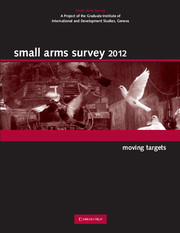Book contents
- Frontmatter
- Foreword
- Contents
- About the Small Arms Survey
- Notes to readers
- Acknowledgements
- Introduction
- Chapter 1 A Fatal Relationship: Guns and Deaths in Latin America and the Caribbean
- Chapter 2 When Business Gets Bloody: State Policy and Drug Violence
- Chapter 3 A Matter of Survival: Non-lethal Firearm Violence
- Chapter 4 Blue Skies and Dark Clouds: Kazakhstan and Small Arms
- Chapter 5 Between State and Non-state: Somaliland's Emerging Security Order
- Photo Essay. Troubled Waters: Somali Piracy
- Chapter 6 Escalation at Sea: Somali Piracy and Private Security Companies
- Chapter 7 Precedent in the Making: The UN Meeting of Governmental Experts
- Chapter 8 Piece by Piece: Authorized Transfers of Parts and Accessories
- Chapter 9 Point by Point: Trends in Transparency
- Chapter 10 Surveying the Battlefield: Illicit Arms in Afghanistan, Iraq, and Somalia
- Index
Chapter 9 - Point by Point: Trends in Transparency
Published online by Cambridge University Press: 05 February 2015
- Frontmatter
- Foreword
- Contents
- About the Small Arms Survey
- Notes to readers
- Acknowledgements
- Introduction
- Chapter 1 A Fatal Relationship: Guns and Deaths in Latin America and the Caribbean
- Chapter 2 When Business Gets Bloody: State Policy and Drug Violence
- Chapter 3 A Matter of Survival: Non-lethal Firearm Violence
- Chapter 4 Blue Skies and Dark Clouds: Kazakhstan and Small Arms
- Chapter 5 Between State and Non-state: Somaliland's Emerging Security Order
- Photo Essay. Troubled Waters: Somali Piracy
- Chapter 6 Escalation at Sea: Somali Piracy and Private Security Companies
- Chapter 7 Precedent in the Making: The UN Meeting of Governmental Experts
- Chapter 8 Piece by Piece: Authorized Transfers of Parts and Accessories
- Chapter 9 Point by Point: Trends in Transparency
- Chapter 10 Surveying the Battlefield: Illicit Arms in Afghanistan, Iraq, and Somalia
- Index
Summary
INTRODUCTION
In a 1991 study intended to encourage the development of the nascent UN Register of Conventional Arms, UN Secretary- General Boutros Boutros-Ghali reasons that ‘transparency can contribute to the building of confidence and security, the reduction of suspicions, mistrust and fear, and the timely identification of trends in arms transfers’ (UNGA, 1991, p. 3). Since that study was published, the commitment to transparency in small arms and light weapons transfers has only grown. In 2008, transparency was recognized as ‘a core element in preventing conflict and securing peace and stability’ (UNSC, 2008, para. 37). In late 2012 the Group of Governmental Experts working on the scope of the UN Register of Conventional Arms will convene to conduct its triennial review of the instrument. At that meeting, experts will—among other things—take stock of states’ reporting practices over time.
The Small Arms Trade Transparency Barometer, published annually by the Small Arms Survey since 2004, uses a standardized set of guidelines to analyse the transparency of small arms exporters. Applying criteria drawn from actual state reporting practices, the Barometer assesses changes in states’ transparency over time.1 This chapter presents the 2012 edition of the Barometer, which covers reports on export activities conducted in 2010 by the 52 countries the Survey has classified as ‘major exporters’—those exporting at least USD 10 million in small arms, light weapons, their parts, accessories, and ammunition in at least one calendar year since 2001.
- Type
- Chapter
- Information
- Small Arms Survey 2012Moving Targets, pp. 282 - 311Publisher: Cambridge University PressPrint publication year: 2012



